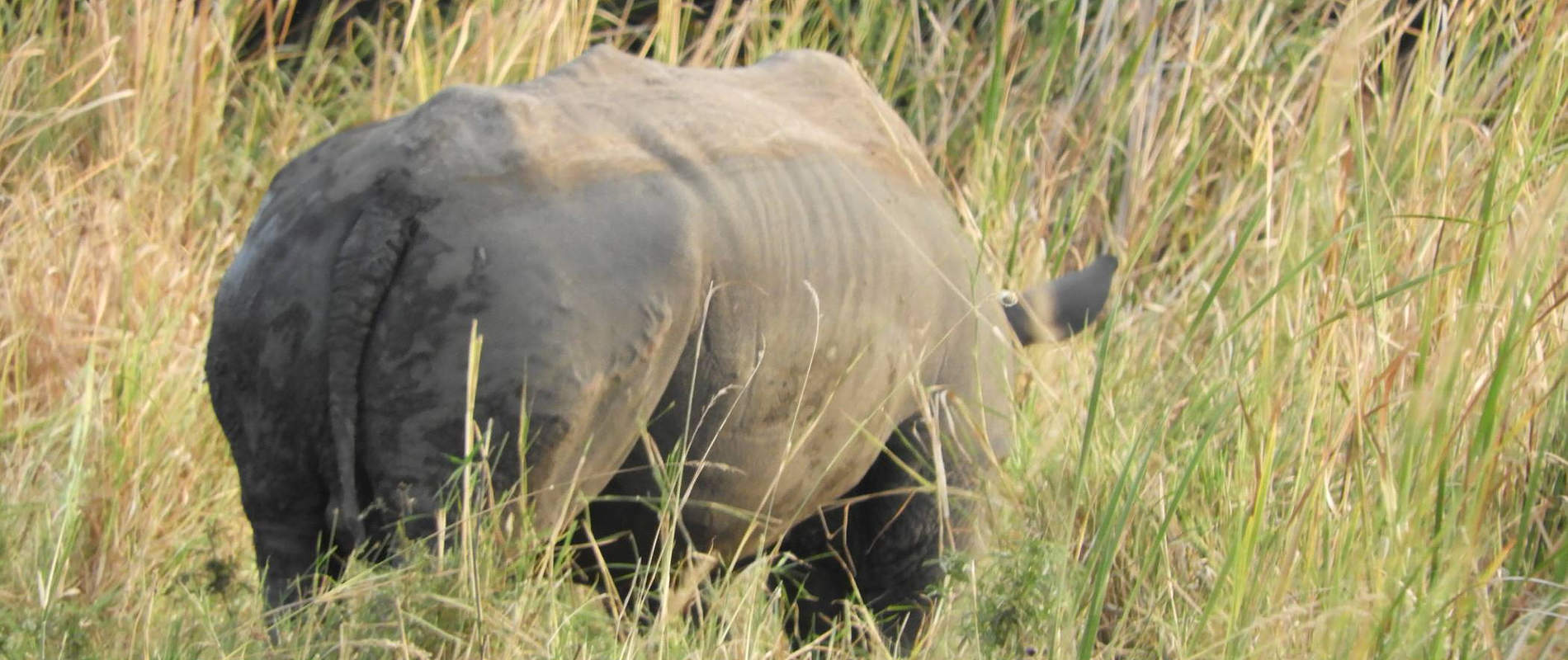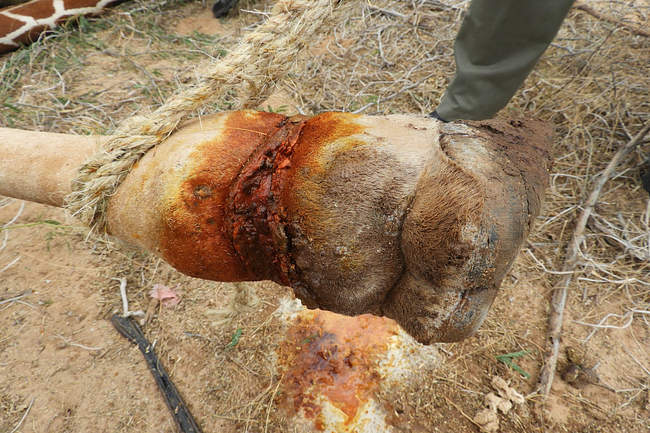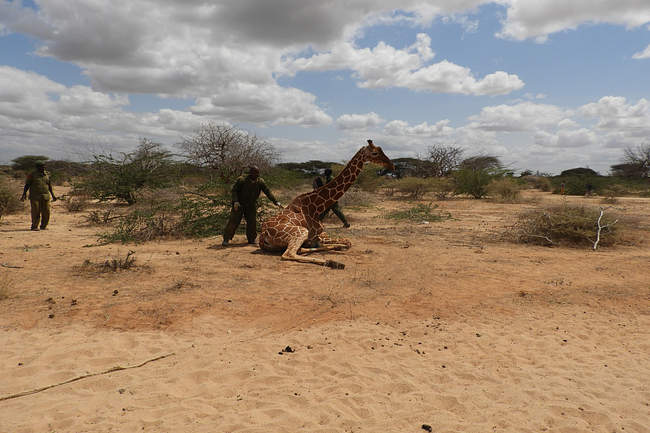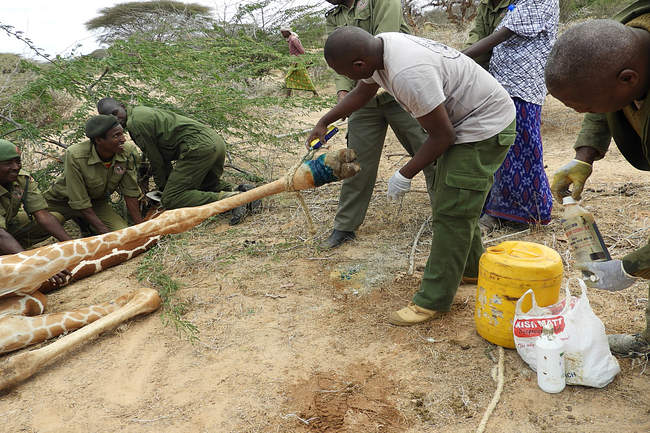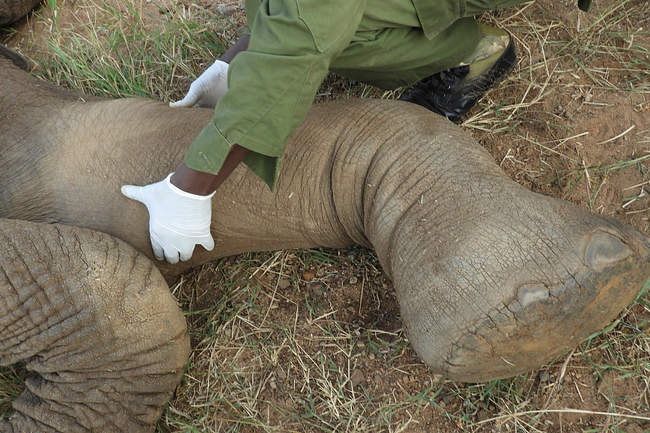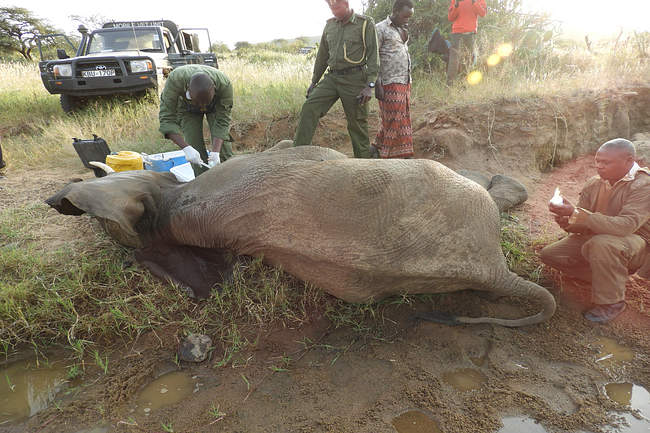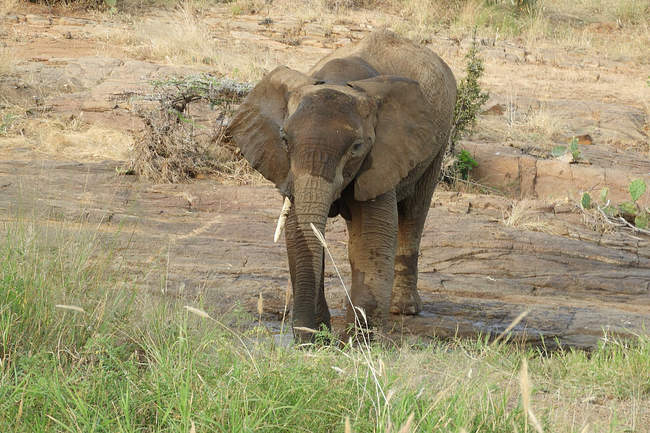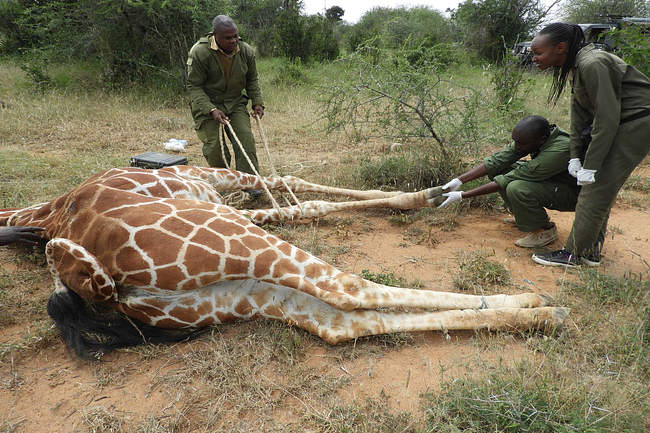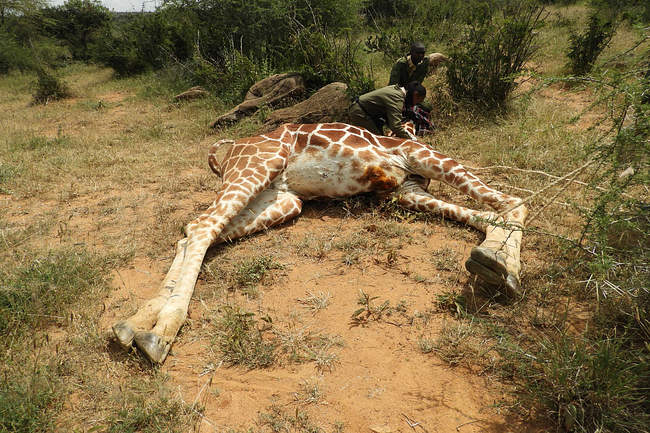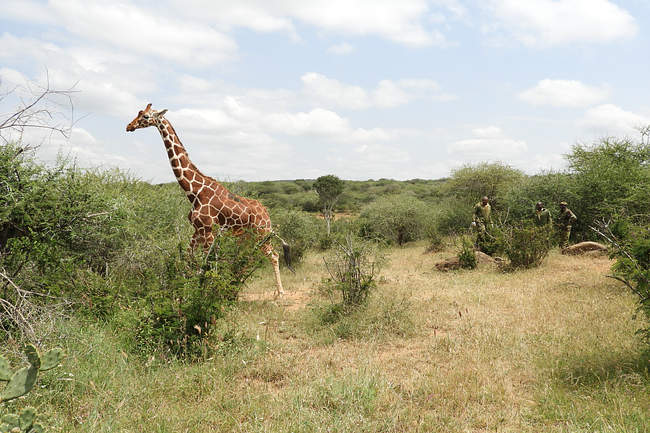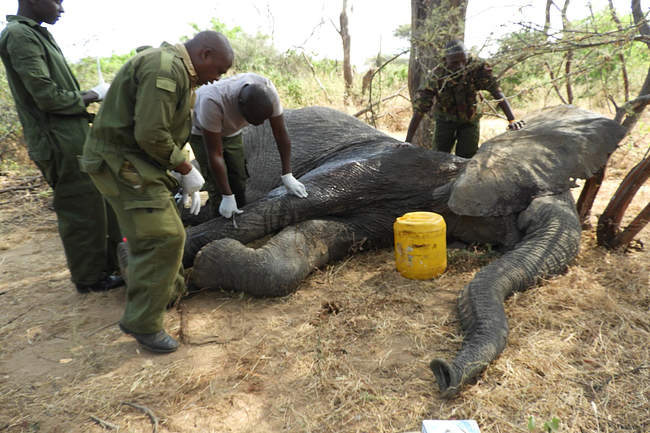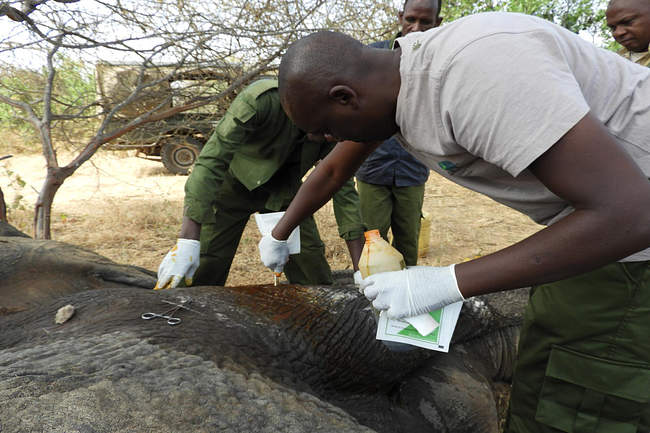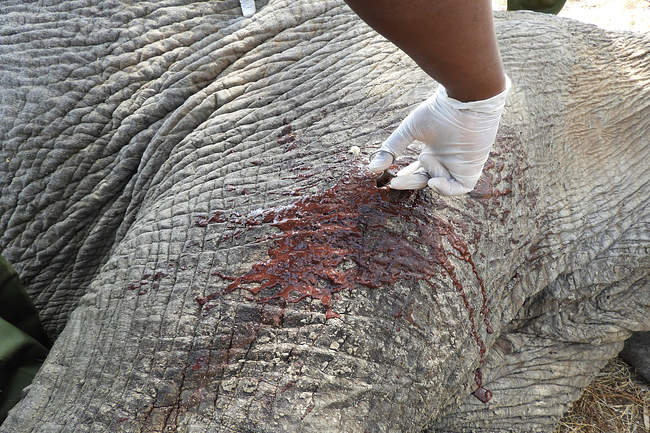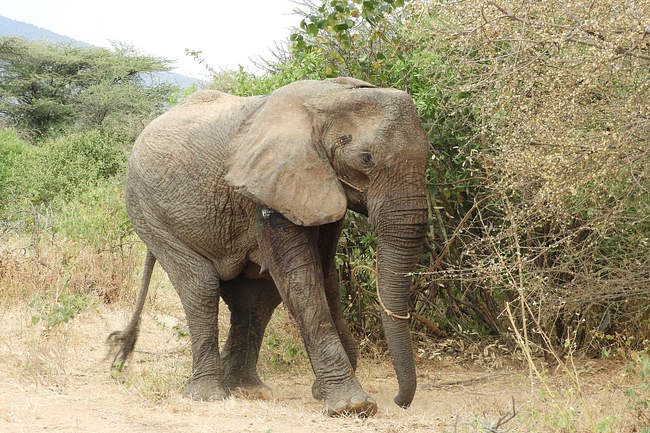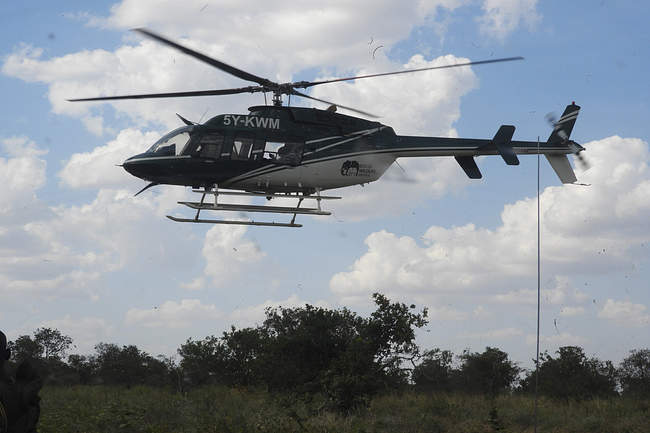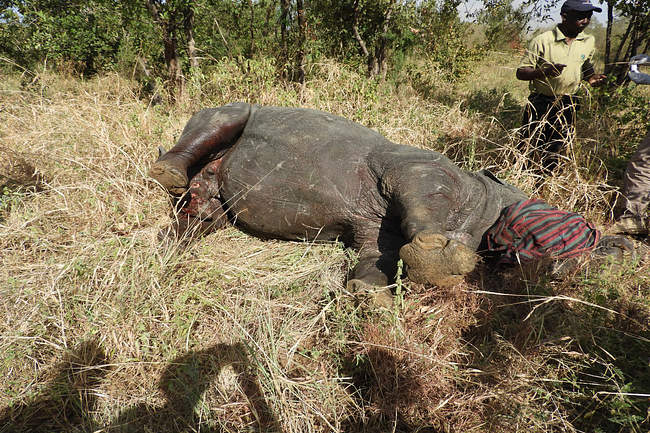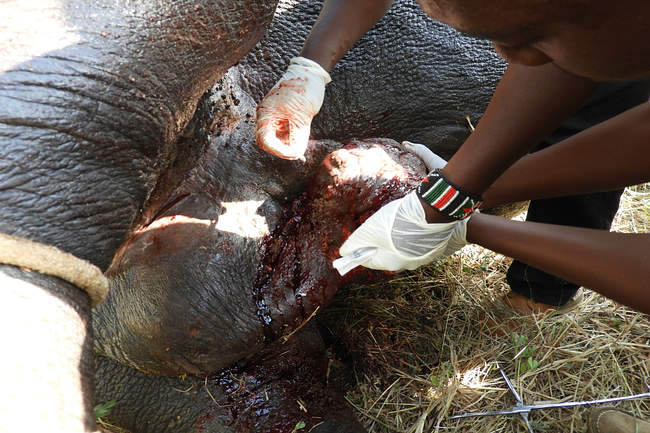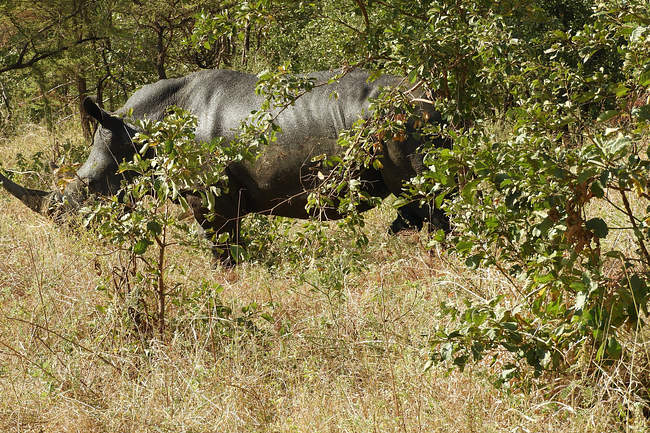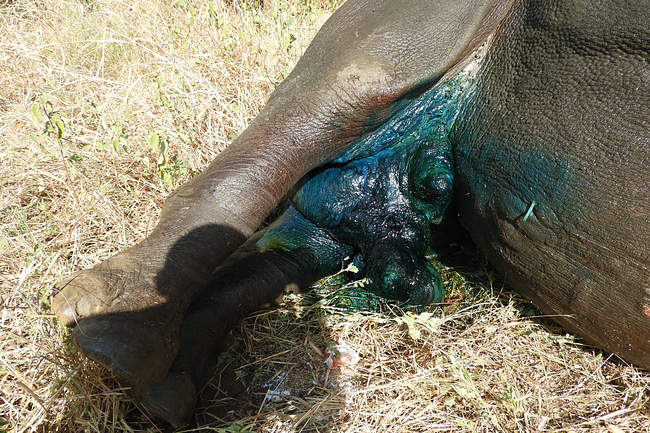The Mara mobile Vet Unit responds to all manner of wildlife emergencies from snares, spears, arrow and gunshot wounds, to injuries caused through human-wildlife conflict. Report by Bernard Rono Veterinary Officer Summary This report describes the activities of the Meru veterinary unit in July 2018
EASTERN CONSERVATION AREA VETERINARY UNIT MONTHLY REPORT - JULY 2018
Report by Bernard Rono
Veterinary Officer
Summary
The unit attended to cases in Laikipia, Samburu, Meru and Garissa. In Laikipia, we collaborated with the Mountain unit to translocate seven lions, involved in human-wildlife conflict, to the larger Meru National Park where data from the lions’ tracking collars shows that they have settled in well within the park. We also relocated a mountain bongo to a new paddock for breeding purposes. In Loisaba ranch we treated a sick elephant, while in Mpala ranch we attended to a giraffe which showed lameness. In Samburu we attended to an elephant which showed severe lameness in Reteti, Namunyak conservancy. In Bouralghy, Garissa we removed snares from 2 giraffe and in Meru national Park we attended to a white rhino which had a swelling believed to be a tumor in the inguinal part.
CASE#1 LION TRANSLOCATION FROM LAIKIPIA TO MERU NATIONAL PARK
Date: 8- 12 July 2018
Species: Lion
Capture site: Naromoru and Mutara ranch, Laikipia
Release site: Meru national park
A pride of seven lions believed to have escaped from one of the ranches in Laikipia settled within the community land in Naromoru where they were killing cattle. The community was also concerned about their safety. This translocation which was carried out in collaboration with the Laikipia mobile veterinary unit aimed to move the lions to a secure place.

All the lions were darted from a helicopter, loaded into secure cage traps for transportation by truck to Meru National Park. Two individuals (one male and one female) were fitted with satellite collars for monitoring. Data from the collars shows the lions have settled well within the park.
CASE#2 SNARE REMOVAL IN A RETICULATED GIRAFFE
Date: 13 July 2018
Species: Reticulated giraffe
Sex: Female
Location: Bouralghy Conservancy, Garissa
History: The KWS warden in charge of Garissa County reported that there were three giraffes with injuries which needed veterinary attention in Bouralghy Community Conservancy. The conservancy which borders Garisssa town, the Tana river and horticultural farms along the river has a teeming population of reticulated giraffe and gerenuk among other wildlife species. Snares in the farm settlements are a big threat to this population of giraffe.
We attended to two giraffes to remove snares while a third giraffe was examined and found to have a deformity of the hind leg which did not require intervention. The first giraffe had a long winch wire snare around its right hind leg with severe lameness and loss of body condition. It was immobilized to remove the snare.

Immobilization, examination and treatment: Immobilization was achieved using a combination of Etorphine hydrochloride 8mg and Azaperone tartate 60mg in a single 3 milliliter dart. It was calm when approached by vehicle and was darted at a distance of 20 meters with the dart placed into the muscles at the rump. After six minutes the drug took effect and it was roped to right lateral recumbence. As the animal stumbled it suffered a transverse comminuted fracture at the mid diaphysis of the right metatarsal bones.
The snare had strangulated the leg, formed dry gangrene and rarefied the bone, predisposing the bone to fracture. Due to the extent of injuries this giraffe was euthanized to relieve suffering. The area warden was advised to sensitize community against use of snares and to launch an operation to remove snares from the environment.
CASE#3 SNARE REMOVAL IN A RETICULATED GIRAFFE
Date: 14 July 2018
Species: Reticulated giraffe
Sex: Female
Location: Bouralghy Conservancy, Garissa
History: Scouts in Bouralghy community conservancy reported that this giraffe showed lameness and a swelling on its right forelimb, injuries believed to have been caused by a snare.

Immobilization, examination and treatment: Immobilization was achieved using a combination of Etorphine hydrochloride 8mg and Azaperone tartate 60mg in a single 3 milliliter dart. The giraffe which was in a group of 30 individuals was approached by vehicle for darting with the dart placed into the shoulder muscle. After darting the giraffe remained calm for four minutes and later galloped as the drug took effect.

It was roped to left lateral recumbency for examination and treatment. A blindfold was applied over giraffes head. Examination showed an infected wound around the pastern and an embedded tight snare which had cut through soft tissue.
The winch wire snare was cut using a wire cutter and removed. The wound was debridded using hydrogen peroxide and an antiseptic was applied. Parenteral antibiotics and anti-inflammatory drugs were administered.

Reversal and Prognosis: After examination anesthesia was reversed by intravenous administration of Diprenophine hydrochloride and restrained physically at the neck for treatment. Eighteen minutes after the initial dart the giraffe was released to join its herd mates. We are confident that the wounds will heal well after removal of the snare and treatment.
CASE#4 LAMENESS IN ELEPHANT
Date: 19 July 2018
Species: Elephant
Sex: Female
Location: Loisaba conservancy
History: Rangers reported severe lameness and swelling on the left front leg of this elephant in Loisaba Conservancy. An assessment was carried out to determine the cause of lameness and treat this elephant.

Immobilization, examination and treatment: We found this lactating female elephant with its 2 year old calf and a defensive bull by a stream in the Conservancy. Darting was carried out from a vehicle with the dart containing Etorphine hydrochloride placed in the gluteal muscle. Induction time was five minutes and it fell on its left lateral recumbency.
The bull and the calf were pushed away by vehicle to allow for treatment. Swelling occurred distal to the shoulder of the left front leg. No wounds were seen and an attempt to manipulate the leg to locate the injury was not successful. Cause of lameness was believed to be joint luxation. Anti-inflammatory and antibiotics were administered by intramuscular route.
Reversal and prognosis: Anesthesia was reversed by intravenous Diprenophine hydrochloride and the elephant was in standing position after 2 minutes. She was soon joined by the calf and the bull. Prognosis in this case is guarded and we advised conservancy rangers to monitor its progress and report back.
Our Mobile Vet Units are in the field every day saving wild lives
CASE#5 LAMENESS IN A GIRAFFE
Date: 20 July 2018
Species: Reticulated Giraffe
Sex: Male
Location: Mpala conservancy
History: Rangers in Mpala Ranch reported that this giraffe had lost body condition and showed lameness and swelling on the lower end of the left front leg. We immobilized this animal to assess the cause of lameness and treat.
Immobilization, examination and treatment: Immobilization was achieved using a combination of Etorphine hydrochloride 8mg and Azaperone tartate 60mg in a single 3 milliliter dart. After darting it remained calm for six minutes and later galloped as the drug took effect. It was roped to left lateral recumbency for examination and treatment.
Examination showed a swollen fetlock joint possibly due to arthritis. No other injury was noted. Anti inflammatory drugs and multivitamin were given intramuscularly.
Reversal and prognosis: Anesthesia was fully reversed after examination by intravenous administration of Diprenophine hydrochloride and this giraffe restrained physically for treatment. We believe this giraffe will recover fully in the coming days.
CASE#6 BONGO RELOCATION IN MOUNT KENYA GAME RANCH
Date: 20 July 2018
Species: Mountain Bongo
Sex: Female
Location: Mount Kenya Game Ranch (MKGR)
A breeding female bongo was relocated to a new paddock to allow intensive and easier monitoring by animal keepers. The bongo was darted on foot after stalking it in the bushes. The dart which contained Etorphine hydrochloride 5mg and Azaperone 40mg was placed at the right gluteal muscles. Down time was 7 minutes.

The bongo was quickly loaded into a truck with wheat straw on the floor for padding and transported under anesthesia on sternal recumbence. Ivermectin and multivitamin, a catabolic stimulant were administered. Reversal was achieved by intravenous administration of Naltrexone hydrochloride and this female soon joined the rest of the herd in her new paddock.<<81720184151-pic1.jpg>><<817201841-pic2.jpg>>
CASE#7 LAMENESS IN ELEPHANT
Date: 26 July 2018
Species: Elephant
Sex: Female
Location: Namunyak conservancy, Reteti
History: This adult female elephant in Namunyak Conservancy showed severe lameness on the left front leg and pus oozing from the right front leg. This lactating female was left behind by rest of the herd and its calf seemed to have joined the group. We immobilized this animal to determine the cause and treat her injuries.

Immobilization, examination and treatment: We darted this elephant by foot. Immobilization was achieved using Etorphine hydrochloride with the dart injected into the shoulder muscle. Five minutes later it was recumbent.
Examination showed a sharp penetrating wound approximately 30cm deep into the right muscles shoulder muscle with pus oozing out. The wound was caused by a spear injury. The swelling on the left front leg was believed to have been caused by joint subluxation in rough hilly terrain. The wounds were washed with water, debridded with dilute Hydrogen peroxide and rinsed in Iodine. Parenteral antibiotics and anti-inflammatory drugs were given.
Reversal and Prognosis: Reversal of anesthesia was achieved by intravenous administration of Diprenophine hydrochloride. Prognosis for this case is guarded due to severe injury on the left front leg.
CASE#8 TUMOR IN A WHITE RHINO
Date: 28/7/2018
Species: White rhino
Sex: Male
Age: > 30 years
Location: Meru national park, Rhino Sanctuary
History: On the 26th of July, the Officer in charge of rhino in Meru National Park reported that a white rhino had a reddish swelling on the penis/prepuce which persisted for at least three weeks. It showed good body condition, well nourished and its mobility was not being affected. This rhino’s territory is within Mururi swamp and has previously been treated for filarial wounds which healed. The rhino was immobilized on the 28th of July for examination and treatment.
Immobilization, examination and treatment:Immobilization was achieved using a combination of Etorphine hydrochloride 4.5mg and Azaperone tartate 80mg in a single 1.5cc dart. Darting was done by helicopter after a brief push.
Induction time was seven minutes. Butorphanol 20mg was given intravenously to partially antagonize effect of opioid and a blind fold was applied. Vital parameters were monitored during the procedure including respiration rate and water was doused liberally to cool his body temperature. Examination showed a firm, reddish nodular swelling on the prepuce extending dorsally on the perineum.
There were sinuses on the proximal part of this mass which appeared dry. No pus was found on aspiration. The preputial orifice was constricted and the penis was felt on palpation. Tentative diagnosis was that it was a tumor on the prepuce. Differential diagnosis include squamous cell carcinoma, abscess caused by a foreign body and chronic traumatic injury. Skin tissue samples of the affected part were collected and preserved separately by deep freezing for microbiology and in formalin for histopathology. Whole blood and serum was also collected and preserved.
Due to the extensive lesions a conservative treatment approach was used. Long acting antibiotics were administered to prevent ascending infection along the urinary tract. Anti-inflammatory drugs and multivitamins were also administered. Laboratory results and regular health progress reports from the field will guide further action on this individual who is still in good body condition but advanced age.
Prognosis: Prognosis for neoplasm which is not amenable to surgical excision is guarded. Because of lesion anatomical location it is prone to injury and infection which can ascend the urinary tract via urethra. In conclusion we advise intensive monitoring of this animal to ensure its welfare is not compromised.
Acknowledgment
Report by KWS Vet Dr Bernard Rono. We would like to thank the KWS management and the David Sheldrick Wildlife Trust for logistical support to enable this unit to treat injured and sick wildlife in northern Kenya.
